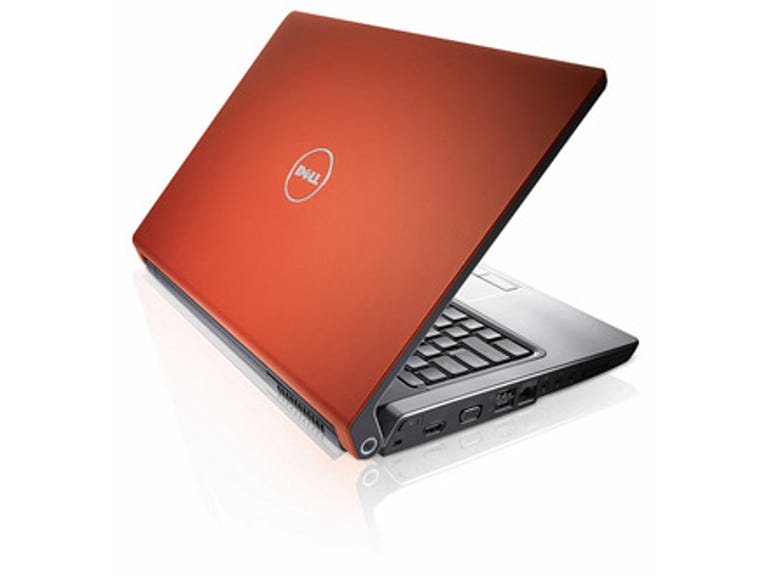 Why You Can Trust CNET
Why You Can Trust CNET Dell Studio 1535 review: Dell Studio 1535
The Dell Studio 1535 is a good mid-range laptop that fills the gap between premium and mainstream, and offers good quality for the price.
Design
A hybrid between the XPS and Inspiron series, the Studio series manages to deliver a sturdy industrial design, with a rubberised laptop lid that comes in eight colours — blue, red, purple, grey, pink, orange, green and black. They all come with a black trim around the side edges of the monitor (known as the "U-Trim" in Dell-speak) unless you order grey, in which case you can opt for a black, red, blue or pink U-Trim.
The Good
The Bad
The Bottom Line
The mouse pad is slightly recessed, and to the right of this is an inlaid design that looks a bit like a synoptic chart — although we keep thinking it's the result of a spilt coffee that no one managed to wipe off successfully. To the far right is a fingerprint reader, at the top of the chassis near the monitor hinge is a speaker bar, and at the top of the monitor itself is the webcam and built-in microphone.
The hinge is inherited from the XPS range, and is quite strong, with a power button on the right-hand side of the laptop where the hinge meets the chassis. Upon powering up, the media buttons at the top of the chassis scan from left to right in a pleasing white glow. A button on the other side of the hinge loads the Wi-Fi Catcher application in Windows, showing relative strength of all the wireless networks in your vicinity.
The screen itself is excellent quality, although if gloss causes you issues you may wish to look elsewhere. The screen is perhaps a bit too thin — as we could see our fingers clearly through the screen based on the discolouration precisely where we were supporting the laptop.
The keyboard is at first a slight shock for those used to shallow keys, as it offers a longer throw and more tactile feedback than the norm. While it took us a while to adjust, we were soon hammering out words at a high pace with no issue.
Features
In what is set to become a common appearance due to Intel's inclusion of eSATA in the Centrino 2 spec, on the left-hand side is a combined eSATA and USB port. The hole in the chassis is slightly wider than usual for a USB port, and the port itself has two extra notches at the top to support the wider eSATA plug — a clever way to include both standards and save on space.
Including this port there are four USB ports in total, one FireWire, HDMI, VGA, gigabit Ethernet, SD/MMC/MS card reader, a microphone port, two headphone ports, an Express Card 54 slot and a slot-loading DVD+-RW drive populating the sides. As an indication of the lowering importance of dial up, a 56Kbps modem is included as a separate, USB powered device. A telephone cable and four-prong adapter are also in the box, and aside from the manuals and install discs, nothing else is included.
On the software side, the laptop we received was running Vista Home Premium, and came equipped with Microsoft Works, Roxio Creator, and the crapware infestation of choice comes from Google, both as Google Desktop, and as Google Toolbar for Internet Explorer. An eBay link on the desktop reinforces the fact that the desktop is for sale.
Dell has also included a new network tool, but is more annoying than helpful, consistently reminding you to turn on the Guest account (usually not a clever thing to do security-wise) and in a few circumstances ran the "Network Repair Wizard" even when our connection was completely fine. All these custom networking applications vendors attempt to design are clearly a perceived shortcoming in the way Windows does its networking, but we've yet to see one of these applications that are actually any good. Curiously, the standard nag-ware antivirus wasn't bundled, however, checking the Dell website reveals that the laptop should be shipped with a 30-day trial of Trend Micro.
Performance
Our review sample came equipped with a 2.5GHz Core 2 Duo T9300, 4GB RAM, Mobility Radeon HD 3450 and a 320GB Western Digital hard drive. It also came pre-packed with a 32-bit version of Windows Home Premium, which means it can't possibly put all that RAM to use — Everest revealing 3,584MB was available to the system, while the System Information panel in Windows only saw the physical size. Task manager reported even less available, at 3,581MB — regardless, not being able to access this memory would be easily fixed by equipping it with a 64-bit version of Vista, an option Dell does not provide.
Despite the Mobility Radeon HD 3450, this isn't really a gaming machine, hauling in a score of 1,830 in 3DMark06. It's much more suited to productivity, as evidenced by the PCMark05 score of 5,461, and has a decent battery life of one hour, 41 minutes and 50 seconds when turning off all power-saving features, setting screen brightness and volume to maximum and playing back a DVD.
The Dell Studio 1535 is a good mid-range laptop that fills the gap between premium and mainstream, and offers good quality for the price.


